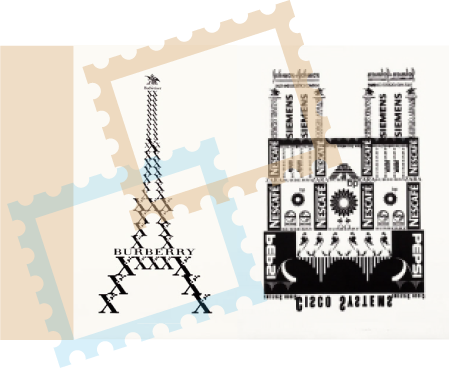BRICKS TO BRANDS
May 5th, 2011
Risto-Jussi Isopahkala’s project “Logo Tourist” invites us to see famous landmarks in a whole new light.

What if the Eiffel Tower was made not of metal bars, but of pieces shaped like Xerox’ iconic pixilated X-shaped logo, crowned with Budweiser Anheuser-Busch’s logo, with the A and the eagle? What if the Louvre was made of AIG, GAP, Caterpillar, Adidas logos?
What if someone built an entire city made of nothing but the symbols of the most successful brands?
This is not the kind of questions most people ask themselves every day, but Finnish artist Risto-Jussi Isopahkala sets out to answer them anyways. The Logo Tourist project consists of modern and edgy black and white images representing diverse historical landmarks and other famous sights composed exclusively of logos from the 100 most valuable brands. Risto-Jussi Isopahkala has thus represented several wonders of Paris (including the aforementioned Eiffel Tower and Louvre, as well as the Arc de Triomphe, the Sacré-Coeur, the Pantheon, and more), plus an unnamed city. Hopefully, more famous cities will join those later.
While the idea might seem more than a bit wacky at first, when you stop and think about it, it makes so much sense it’s almost frightening. Isopakhala himself has this to say about his project:
“[...] monumental architecture [...] symbolizes values that are not generally considered as merchandise. For tourists these are nevertheless consumable commodities, available to outsiders as well. Stereotypes of cities, such as Paris, can be transferred and consumed everywhere. Identity is comprised of consuming.”
The message Isopahkala conveys is that those famous monuments, which carry in themselves values that would seem above mere commerce, such as the very identity of a nation, have nevertheless been reduced to objects of consumption as tourists come and pay to see, visit, and photograph them. But the reverse is also true!
If landmarks are becoming brands, then brands, in return, are becoming something like landmarks: a part of our life which is so important, that by themselves those logos are just as recognizable as the monuments Isopahkala composes out of them. These days, you can meet someone who does not recognize the Notre-Dame cathedral, but it would be highly improbable to encounter one who does not recognize McDonalds’ characteristic M or the Pepsi logo.
If you have been following our blog, you might have read my previous article about the short film “Logorama”, the characters and settings of which are composed entirely of logos and brands of all kinds. One could say that Isopahkala’s work is somewhat of a spiritual sequel to “Logorama” as it takes the idea to a whole new level. Brands are not simply part of everyday life: they are part of our identity, of our very system of values. In a world where national monuments become brands and brands have more influence than national monuments, one cannot overstate the importance of branding for a company.
Therefore, make sure that your logo is as pleasant to the eye as possible, so that your own “landmark” too can be seen as an aesthetic work of art. To do so, when building your company, call upon the master architects of the branding world: professional logo designers.
Many thanks to Logo Design Love for helping us find out about this amazing project.




